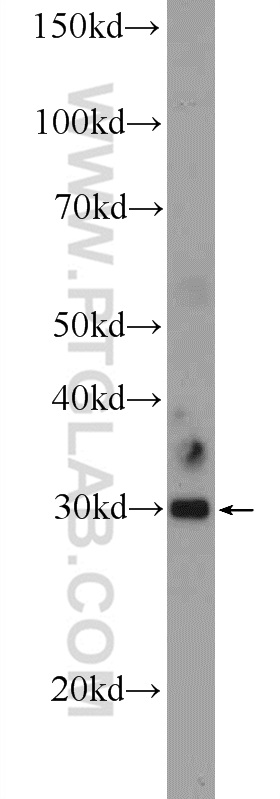C11orf57 Polyclonal antibody
C11orf57 Polyclonal Antibody for WB, IHC, ELISA
Host / Isotype
Rabbit / IgG
Reactivity
human, mouse
Applications
WB, IHC, ELISA
Conjugate
Unconjugated
验证数据展示
经过测试的应用
| Positive WB detected in | mouse brain tissue |
| Positive IHC detected in | human breast cancer tissue Note: suggested antigen retrieval with TE buffer pH 9.0; (*) Alternatively, antigen retrieval may be performed with citrate buffer pH 6.0 |
推荐稀释比
| Application | Dilution |
|---|---|
| Western Blot (WB) | WB : 1:200-1:1000 |
| Immunohistochemistry (IHC) | IHC : 1:50-1:500 |
| It is recommended that this reagent should be titrated in each testing system to obtain optimal results. | |
| Sample-dependent, Check data in validation data gallery. | |
发表文章中的应用
| WB | See 1 publications below |
产品信息
21181-1-AP targets C11orf57 in WB, IHC, ELISA applications and shows reactivity with human, mouse samples.
| Tested Applications | WB, IHC, ELISA Application Description |
| Cited Applications | WB |
| Tested Reactivity | human, mouse |
| Cited Reactivity | human |
| Immunogen | C11orf57 fusion protein Ag15471 种属同源性预测 |
| Host / Isotype | Rabbit / IgG |
| Class | Polyclonal |
| Type | Antibody |
| Full Name | chromosome 11 open reading frame 57 |
| Synonyms | C11orf57 |
| Calculated Molecular Weight | 293 aa, 34 kDa |
| Observed Molecular Weight | 30-34 kDa |
| GenBank Accession Number | BC030546 |
| Gene Symbol | C11orf57 |
| Gene ID (NCBI) | 55216 |
| RRID | AB_2878825 |
| Conjugate | Unconjugated |
| Form | Liquid |
| Purification Method | Antigen affinity purification |
| UNIPROT ID | Q6ZUT1 |
| Storage Buffer | PBS with 0.02% sodium azide and 50% glycerol pH 7.3. |
| Storage Conditions | Store at -20°C. Stable for one year after shipment. Aliquoting is unnecessary for -20oC storage. |
背景介绍
实验方案
| Product Specific Protocols | |
|---|---|
| WB protocol for C11orf57 antibody 21181-1-AP | Download protocol |
| IHC protocol for C11orf57 antibody 21181-1-AP | Download protocol |
| Standard Protocols | |
|---|---|
| Click here to view our Standard Protocols |


